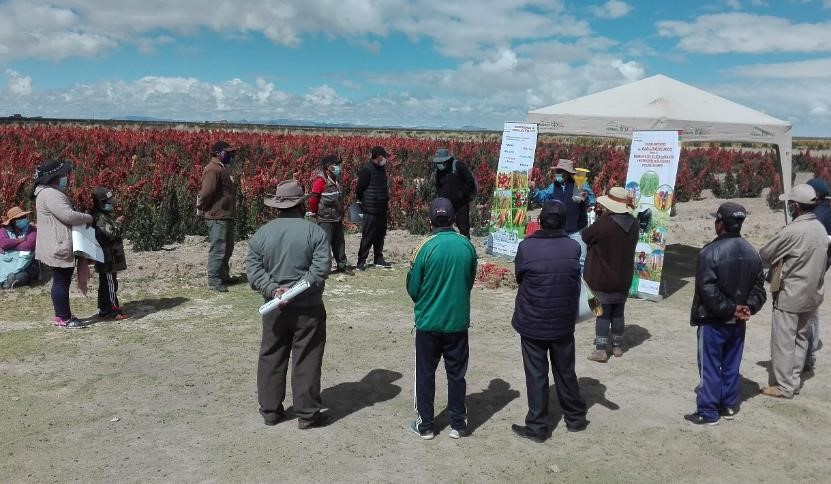Challapata, March 23, 2021, hours 10:00 am (PROINPA Foundation). In the community of Ankasoca, belonging to the municipality of Challapata, Eduardo Abaroa province of the department of Oruro, 19 quinoa-producing farmers attended the Demonstrative Field Day, where they interacted on the Management, Control and Efficient Use of Bioinputs for the Organic Production of Quinoa, an event convened by technicians from the PROINPA Foundation (Promotion and Research of Andean Products).
YoVíctor Calani, President of the Territorial Base Organization of the Ankasoca Community, inaugurated the Demonstrative Field Day, stating the following: “It is very important that people know that the natural products that are used when we sow is to strengthen the soil.”.
“We are from the PROINPA Foundation and we are in this Field Day promoting the use and access of bio-inputs. Bioinputs are products that have come from plants, extracts, soil microorganisms, all of them are accepted for organic production and are used in different crops. The objective is to show the results of the application of these bio-inputs in quinoa and based on that the producer decides whether to use it or not, and from where they can access it. Likewise, we are here to guide you how to control pests, when to apply and what bio-inputs you should use”. This activity is carried out within the framework of the project "Strengthening and promotion of the efficient use of bio-inputs for pest management and crop nutrition in producers of the Bolivian altiplano", financed by the Swiss and Swedish Cooperation and executed by Swisscontac in alliance with the Foundation PROINPA, stated Reinaldo Quispe, Project Coordinator.
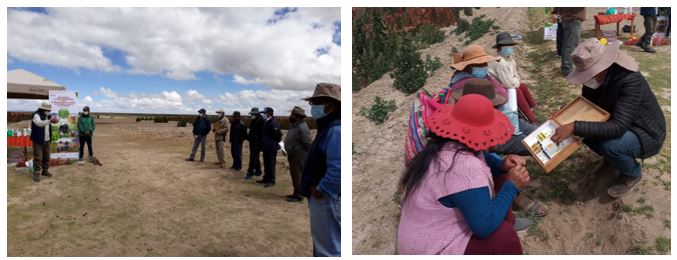
José Olivera (PROINPA) recommended: “In the Altiplano, the only thing that can save us is the production of organic quinoa, now the whole world produces conventional quinoa. Before, quinoa cost 2,200 Bs. per quintal; Now it costs 350 Bs. how much is the difference? more than a thousand and has anyone ever wondered what are the factors? The chemists. Unfortunately today many countries produce conventional quinoa with better technology and in a mechanized way; but our country needs to consolidate the production of organic quinoa because there is a market that values this type of product, which is why PROINPA has developed a quinoa production strategy with bio-inputs”.
He described the products that can be used from planting to harvest, for example TRICOBAL and its role in promoting plant growth, thickening stems and controlling soil diseases, VIGORTOP for plant growth and development, and for the control of pests such as "ticona" and "moth" the use of traps with Pheromone for adults and BIOMAX for larvae.
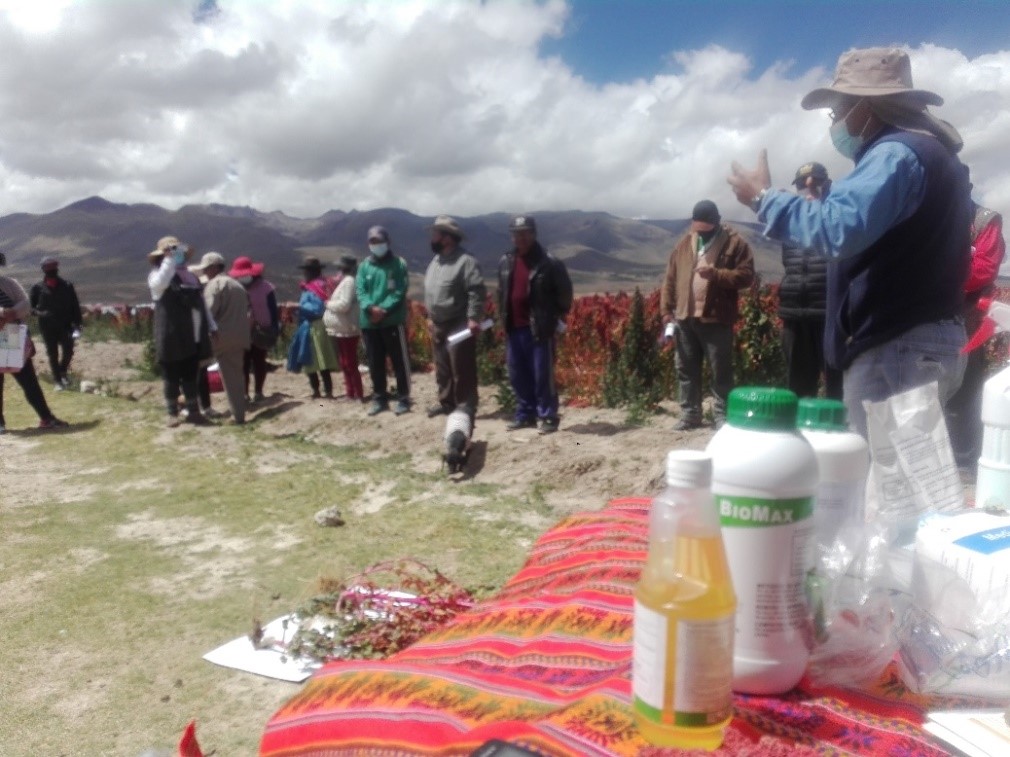
Testimony:
Eddy Calani Farmer Producer of Quinoa from the Ankasoca Community, He informed the farmers of his experience on the use and results of the application of bio-inputs in his quinoa plot. "I am going to tell my experience, I have used the EnergyTop bio-input, it is much better if the Energy Top with the seed is prepared before, at 3 in the afternoon of October 8 I have mixed the EnergyTop with the quinoa seed and I have spread it in the shade where it has dried in 15 minutes, and the seed was ready to take to the tractor seeder and we sowed at night. What an experience, it is better to always try it, no! I am feeling it, living in my own flesh, for this I have used EnergyTop, it has been very effective, as you can see the development of the quinoa plants is different, they have more panicles.
For pest control, “I have used the pheromones together with the traps, we have installed this when the quinoas should have been 20 cm high and how did this help me? Because in past years I have not used the traps, I have always used chemicals. One trap has caught 168 Ticonas per week, and since I have set 3 traps 504 Ticonas have been caught per week, it helps reduce the spread of Ticonas, the females can no longer mate, can no longer reproduce. When the plants are small, what you have to take care of are the heads of the panicles and the Pheromone has helped a lot, the truth is as if we would be spraying almost every day, but it is trapping. In this way I have lived in my own flesh, performing all the procedures, I have simply used the Energy Top and Pheromone Traps. We can see the size of the panicles and I am very surprised, this is the first year that I have this quality of panicles in this field and I recommend brothers to use these bio-inputs”.
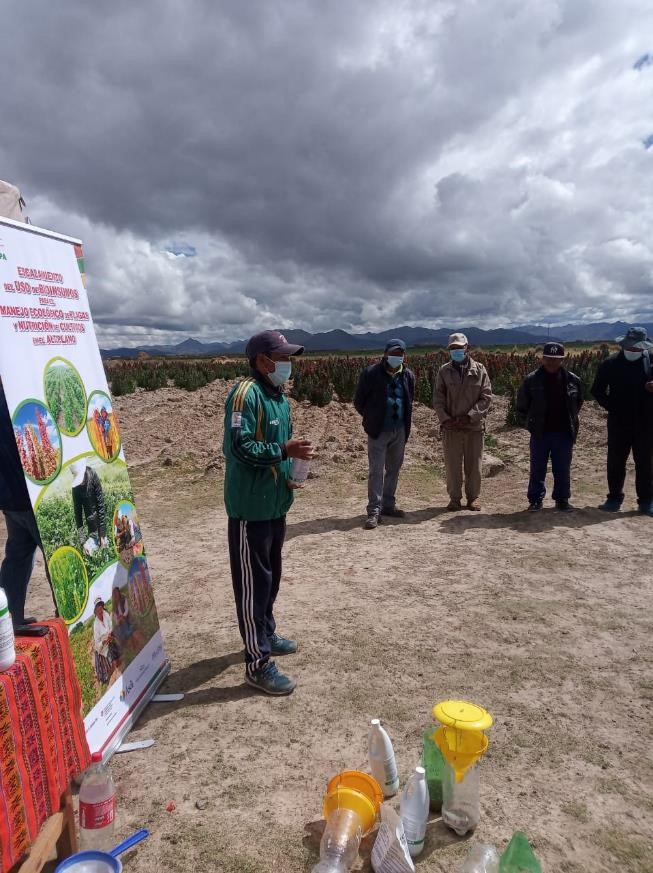
Use of moth traps, “It is the other pest that attacks quinoa. This product of a 100% has helped us a lot. There must be a 10% of worms in the plot, so let's use brothers, the prices aren't very high either, it's a joy to have this type of panicle. Sometimes it is good to dedicate a little more to quinoa and we obtain this type of production, this would be my experience with the use of Energy Top, Pheromones for "ticone and moth" and traps.
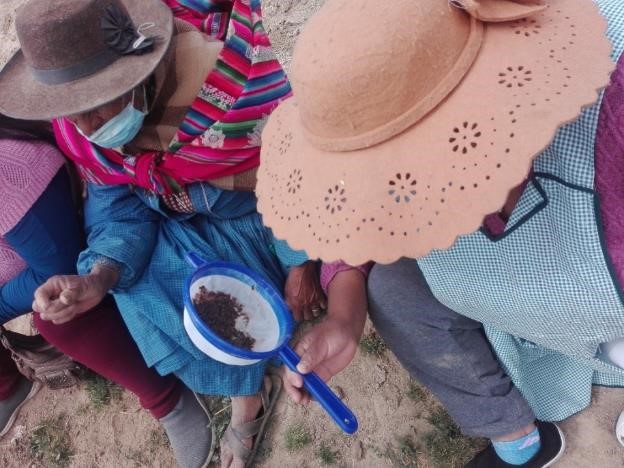
When visiting his quinoa cultivation plot, comparing it with neighboring crops (control); without the use of bioinputs they looked smaller. “Before I harvested 7 sacks, now I am thinking of collecting 10 sacks or more, I am also putting organic products on the ground and I am not damaging with chemicals” Eddy Calani finished very happy.
Walter Rosendo Poquechoque Arias, Ayllu Callawi del Calledon Norte, Challapata Canton Eduardo Abaroa-Oruro Province
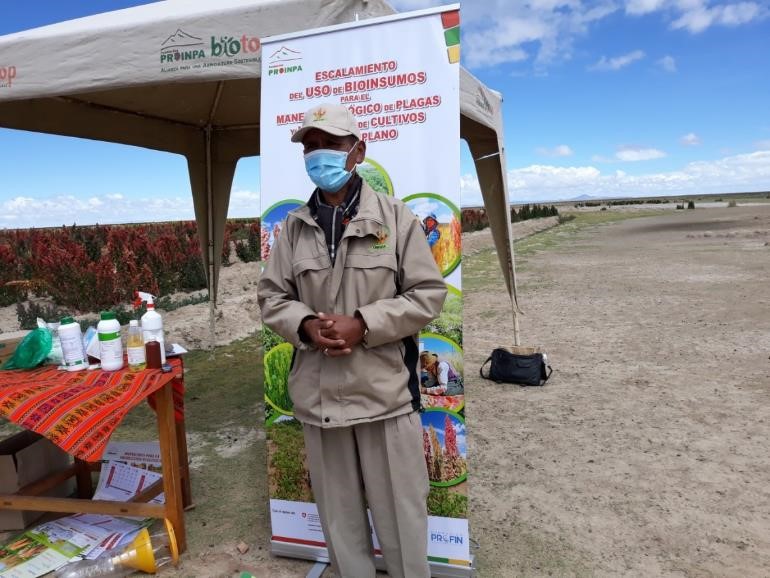
(PROINPA) who visited me and gave me the EnergyTop product to this product I want to say thank you it is really doable i would recommend brothers. Quinoa should be sown at night, not during the day, that is practical work. It should be sown at night because there is moisture, the seed begins to enter, it absorbs and produces well. You also have to know what time the tractor is going to sow and with half an hour or an hour to go you have to mix the seed with the product, dry it and sow. Previous years I lifted 8 sacks, now I have lifted 19 brothers”.
In the case of Biomax, “There are claims, people complain that it doesn't kill like the fast chemical, but if we fumigate today, tomorrow it starts killing more, this is the difference and we also don't damage the soil. From January, February and March we know that the worms are arriving and the crop must be taken care of, fumigate 2 to 3 times, in which case the plant would be clean without "ticonas" and "moths".”. Regarding the seeds, he recommended using a variety of those certified by INIAF.
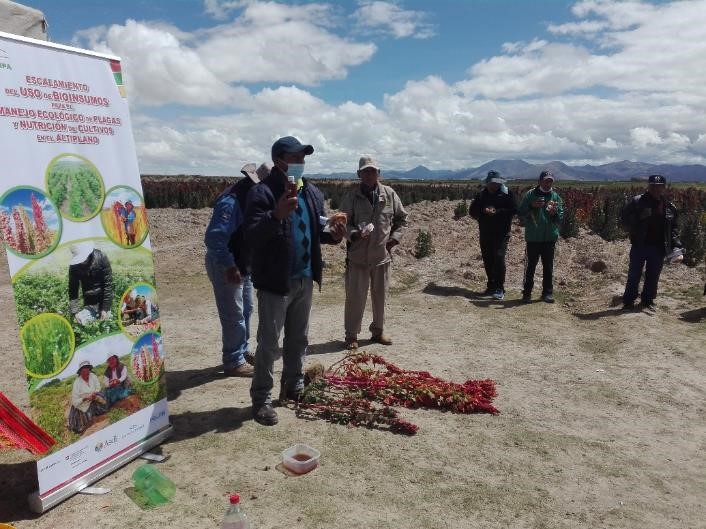
Isidoro Villca Escobar, Former Technician of SENASAG Challapata, Community of Crucero Tierras Altas. “I would like to comment on the use of the product offered by PROINPA. Since I was a SENASAG technician, I had coordinated with the engineers Raúl Saravia, José Olivera (PROINPA) and José Arancibia (GAM-Challapata), then brothers as engineer Arancibia. He has brought the product and gave a 100 ml bottle for the Energy Top promotion and he explained quickly, you have to use it at the moment, not missing hours because the product evaporates and that is what I did ".
“I am the son-in-law of Salinas de Garci Mendoza, I have 2 hectares and a little more, but as you can see (showing large quinoa plants) it is my quinoa with this product that I have used, like this with heads, but unlike their neighbors they are simple no more I have gone to harvest, I have even brought 2 people to help and they tell me, what have you grown like this with? the production".
Mario Cañaviri, Ankasoca Community. “We have practiced sowing at night and that has germinated and we have rescued it. Knowledge works, brothers. Perhaps we lack practice or still know how to handle fumigation. As a community member, I ask that it should be more closely and I thank brother Eddy for continuing, because he cares about us and his community, he has the support that our partner needs.", …I want to learn to have a lot of knowledge…!
“Today they have learned to use the strategy and see what the difference is, there is the alternative of the products and here we are the engineers to explain and facilitate. At PROINPA, we are always researching and improving our products”José Olivera finished.
The event was closed by Víctor Calani, President of the Ankasoca Community Base Territorial Organization, who thanked PROINPA on behalf of the community for the teachings on caring for the soil and using organic products that are not only for quinoa, but also for potatoes. , vegetables and others.
Angélica Vircaes Fernández, Ankasoca Community. “It seems good to me that these products are being applied by those of my community, I am going to use them in the next planting, I have not used them because after we planted the product has arrived.”.
Tomas Cepeda Poma, Ankasoca Community. "I thank you for this Field Day, for having taught us and encouraged us, I am hopeful with the products, I already used the Energy Top and my quinoa is fine, in the next planting I will use the others."
Freddy Wiracocha, Pequereque Community. “It seemed very good to me and we must follow the process carefully until the harvest, in this next planting I will use the products”.
